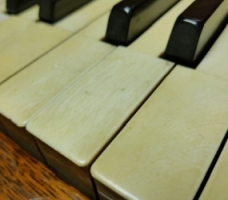  Ivory is a hard, white material from the tusks and teeth of animals, traditionally elephants. It consists mainly of dentine, one of the physical components of teeth and tusks, but also contains mineralised collagen.
Ivory is a hard, white material from the tusks and teeth of animals, traditionally elephants. It consists mainly of dentine, one of the physical components of teeth and tusks, but also contains mineralised collagen.Ivory is hard enough to have been used used in a variety of applications, including false teeth, dominoes, cutlery handles, scrimshaw (carvings), and piano keys. It has high stiffness, strength, hardness, and toughness. The international trade in ivory of threatened species such as elephants is now illegal. 
Both Greek and Roman civilizations practiced ivory carving to make many high value works of art, precious religious objects, and decorative boxes for costly objects. Ivory was often used to form the whites of the eyes of statues. Chinese craftsmen carved ivory to make everything from images of deities to the pipe stems and end pieces for opium pipes. The Syrian and North African elephant populations were reduced to extinction, probably due to the demand for ivory in the Classical world.  Ivory used to be used exclusively in the manufacture of piano keys. With the sale of ivory being illegal, this has now been repaced by the use of plastic, or synthetic ivory. Nevertheless, many older pianos with ivory keys remain. Here are a few simple ways to determine whether your ivory keytops are real or not.
Ivory used to be used exclusively in the manufacture of piano keys. With the sale of ivory being illegal, this has now been repaced by the use of plastic, or synthetic ivory. Nevertheless, many older pianos with ivory keys remain. Here are a few simple ways to determine whether your ivory keytops are real or not.
 The use and trade of elephant ivory became controversial because it contributed to seriously declining elephant populations in many countries.
In the ten years preceding the first decision in 1989 to ban international trade in African elephant ivory, the population of African elephants declined from 1.3 million to around 600,000. Because of this, the importation and sale of ivory in many countries continues to be banned or severely restricted today.
The use and trade of elephant ivory became controversial because it contributed to seriously declining elephant populations in many countries.
In the ten years preceding the first decision in 1989 to ban international trade in African elephant ivory, the population of African elephants declined from 1.3 million to around 600,000. Because of this, the importation and sale of ivory in many countries continues to be banned or severely restricted today. Since the ivory ban, some southern African countries have claimed their elephant populations are stable or increasing, and argued that ivory sales would support their conservation efforts. Other African countries oppose this position, stating that renewed ivory trading puts their own elephant populations under greater threat from poachers. In 2008, eBay banned all international sales of elephant-ivory products on its site. The decision came after several mass slaughters of African elephants, most notably the 2006 Zakouma elephant slaughter in Chad. In June 2015, more than a ton of confiscated ivory was crushed in New York City's Times Square by the Wildlife Conservation Society to send a message that the illegal trade will not be tolerated. The Society has pointed out that the global ivory trade still leads to the slaughter of up to 35,000 elephants a year in Africa. China was the biggest market for poached ivory but announced they would phase out the legal domestic manufacture and sale of ivory products in May 2015. In September of the same year, China and the U.S. announced they would "enact a nearly complete ban on the import and export of ivory". A 2019 study reported that the rate of African elephant poaching was in decline, but recommended action to both reduce demand for ivory in China and other main markets and to decrease corruption and poverty in Africa. |